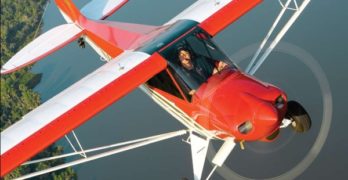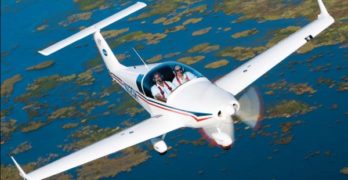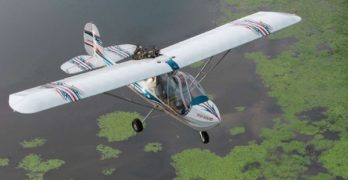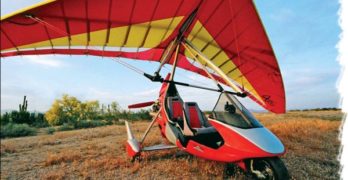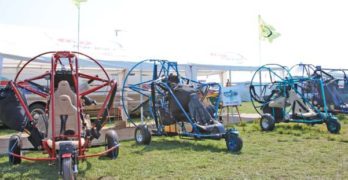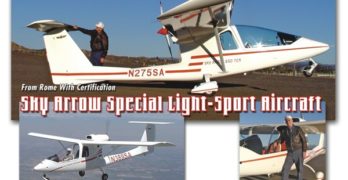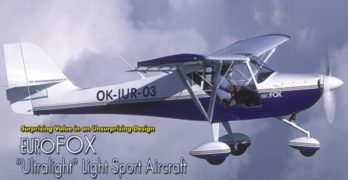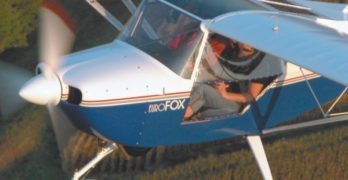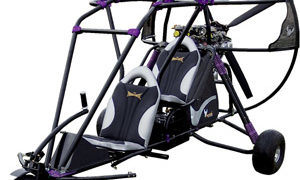Vintage Looks Mated With Modern Materials
Take 25 years of experience
with rebuilding Piper Cubs,
add a new FAA regulation
allowing more flexibility in designing
and producing aircraft, spice the
mixture with many design changes,
and you get CubCrafters’ Sport Cub.
The Yakima, Washington-based company
has created an airplane that retains
the vintage look of a J-3 Cub
but embraces 21st century materials
and technology.
On a warm evening during
the Sun ‘n Fun Fly-In
at Lakeland, Florida, I
flew with CubCrafters’
pilot Clay Hammond. He
identified company President
Jim Richmond as the primary
motivator behind the Sport Cub.
Richmond has been rebuilding Cubs
for 25 years, during which time he
conceived many changes he wanted
to try. Taking into consideration his
height-he’s 6 feet 4 inches tall-he
wanted to make all the improvements
he’d envisioned for the venerable
Cub, and he wanted the airplane
to fit him.
A Thoroughly Modern Cub
CubCrafters took on the redesign
of the 50-year-old airplane using
modern materials and engineering
software not available to Piper engineers
when the J-3 was created.
Search Results for : Rotax electric
Not finding exactly what you expected? Try our advanced search option.
Select a manufacturer to go straight to all our content about that manufacturer.
Select an aircraft model to go straight to all our content about that model.
Canadian-Designed Czech-Built Skylark
A Doubly International LSA
SportsPlanes.com imports several
light-sport aircraft (LSA)
that have found ready buyers.
After researching through
several designs, SportsPlanes’ owner
Josh Foss originally settled on the
Comco Ikarus C42 and Breezer and
the U.S.-built American Flyer for its
fleet. Most recently, the company
added the Czech-built Dova Skylark
to its offerings.
However, the real story of this company
is not Josh Foss’ care in the selection
of what airplanes to sell. What
may be more important to the marketplace
is the network his company
has built to bring service and support
to SportsPlanes.com’s customers.
Currently, 15 SportsPlanes centers are
operating, with the goal to establish
25 centers nationwide.
Investigating the Skylark
My opportunity to fly the Skylark
came while attending the U.S. Sport
Aviation Expo in Sebring, Florida, in
January. I flew with Darrell Hamilton,
the SportsPlanes representative
for Florida.
Darrell retired from Northwest
Airlines four years ago. He most recently
crewed the fly-by-wire Airbus
A320, which needs only small control
movements.
The Sport Hornet
Is It the First Ultralight SLSA?
Among fixed-wing airplanes, the Sport Hornet from Higher Class Aviation
may be the first ultralight-type airplane to achieve special light-sport
aircraft (S-LSA) status. Several weight-shift trikes and a few powered
parachutes also have made the jump, making declarations of meeting the
ASTM industry consensus standards.
As company owner Robert Gaither and his team made the Hornet ready for the
LSA market, the airplane was put through a series of changes resulting in the
name Sport Hornet.
From Hornet to Super Hornet to Sport Hornet
Jim Millett, of U.S. Light Aircraft,
designed the original Hornet thinking
he could improve upon the Quad
City Ultralight’s Challenger. His was
a ground-up different design that had
only the look of a Challenger. Much
of what Jim created remains on the
Sport Hornet of today, but much has
also changed, sometimes to meet
S-LSA requirements and sometimes
because it was the right thing to do.
A Sport Bike of the Air
First weight-shift S-LSA sets the bar high
In street vernacular, the term
“crotch rocket” refers to a lean,
lightweight, high-performance
motorcycle. Sometimes called sport
bikes, these machines have become
radically snazzy in modern years by
the addition of rakish body panels.
Sport bikes accelerate like a rocket.
They corner tightly, and they turn
heads wherever they go.
The first weight-shift trike to earn
special light-sport aircraft (S-LSA) approval,
the Air Creation Tanarg might
be compared to just such a vehicle. In
fact, that’s precisely how its French
manufacturer describes its newest
machine.
Yet, while sport bikes are touchy
and have less margin for error than
other motorcycles, Air Creation’s flying
sport bike is highly stable with predictable
handling. Compare Tanarg’s
performance to other trikes, and it
comes out as a top-of-the-line entry.
The name Tanarg comes from the
highest mountain range in the Ardeche
region of southern France, not
far from the Air Creation factory.
To Infinity…and Beyond!
The world of light-sport
aircraft (LSA) includes five
classes of aircraft-airplanes,
gliders, powered parachutes, weightshift-
control aircraft (commonly
called trikes), and lighter-than-air
aircraft (balloons and airships).
While fixed-wing airplanes may be
the most prolific, they are not the
only way for flight enthusiasts to
take to the sky. Weight-shift trikes
and powered parachutes (PPCs) are
also popular modes of flights. Each
offers a different experience to pilot
and passenger.
Some fixed-wing pilots claim
no interest in powered parachutes.
While PPCs certainly aren’t fast,
they do offer one of the best viewing
platforms in aviation and have
attracted a higher percentage of
non-pilots as buyers than any other
aviation segment. That fact alone
should cause more aviators to look
closely at them.
So far three powered parachute
companies have obtained special
LSA (S-LSA) approval for their
models. The first to achieve this
was the Summit 2 from Summit
Powered Parachutes in April 2006.
Sky Arrow Special Light-Sport Aircraft
Ultralight pilots
may not believe the Sky Arrow has achieved Part 23 certified status the same as a Cessna or Cirrus, but it has done precisely that. This sleek Italian tandem 2-seater earned European JAR/VLA certification and, after careful review, FAA gave its approval under international reciprocity agreements.
That makes the Sky Arrow something like the RANS S-7, which won approval under FAA’s last new certification program, Primary category. As a side note, the Kansas company also received its S-LSA airworthiness certificate with less challenge than companies that had not taken the earlier effort
Therefore, once FAA introduced the Light-Sport Aircraft regulation, few were surprised that the Sky Arrow could win approval. In fact, the aircraft was number 18 out of ranks that have now swelled to 40 new models approved.
Let’s forget about FAA approval for the moment and focus on the Sky Arrow’s ability to fly much like an ultralight.
Surprising Value in an Unsurprising Design
On September 1, 2004, when the Federal Aviation Administration (FAA) released the long-anticipated Sport Pilot and Light-Sport Aircraft regulations, a new aviation segment called light sport aircraft (LSA) was created. Some saw LSA as a bridge between ultralights and general aviation aircraft, but are LSA so different from ultralights? The answer is a mixed yes and no.
Yes, many aircraft look different in that the extra weight they may possess allows them to have full composite fuselages, a panel full of instruments even including fancy glass cockpit hardware, plus they can be delivered ready to fly even as 2-seaters. That’s different than our ultralight trainers or our amateur-built recreational aircraft that resemble those trainers. Prices for these light sport aircraft have pushed them beyond the budgets of many pilots.
On the other hand, these aircraft needn’t be all that different from ultralights. The new rule doesn’t require that they weigh the maximum 1,320 pounds.
The EuroFox Offers Affordable Quality
Repatriate means “to restore or return to the country of origin.” That’s exactly what’s happening with the Aeropro EuroFox, an Eastern European-built light-sport aircraft (LSA) based on American design work. It’s coming to this country as a ready-to-fly LSA through importer Rollison Light Sport Aircraft (RLSA).
Just as a car made in Detroit may incorporate a considerable number of parts that were manufactured overseas, LSA can be a combination of United States- and foreign-built parts as well. That’s not unusual in the aviation world. Consider that a new Boeing airplane is likely to have many parts manufactured in other countries. When Boeing competes against Airbus, it may be important to give some work to a country that may buy billions of dollars of airliners. Therefore, even a Boeing aircraft is not 100 percent made in America.
In the LSA world, aircraft manufactured in foreign countries may be delivered to the United States without instruments or other accessory equipment, or that equipment may have been built in the United States and shipped overseas for installation in the aircraft.
Aeropro EuroFox
His Rollison Light Sport Aircraft (RLSA) company has been building a fleet of aircraft for sale from European sources. Rollison has represented numerous brands over the years he’s been involved in light-sport aviation. First he represented American brands and later European. Recently he’s traveled to South America to see what’s available. Today, Rollison sells the Remos G-3 Mirage, the Ikarus-Comco C42, and the EuroFox. He’s associated with Allistair Wilson who is making his own Astra trikes. Of the fixed-wing models in RLSA’s hangar, the EuroFox is the most modestly priced with the C42 next highest and the G-3 as RLSA’s top-of-the-line model.
More Than Familiar?
Many Ultralight Flying! readers will say the EuroFox looks to be a copy of a Kitfox. In fact, says Rob Rollison, this simply isn’t true.
The EuroFox certainly shares heritage with the Kitfox but is actually a downstream development of the Avid Flyer. In the Slovak Republic, where the four founders of Aeropro live, plans were used to build an Avid.
SLSA Number 50 Is Powrachute’s AirWolf 912
Right at the two year point since the first Special Light-Sport Aircraft approval, Powrachute’s AirWolf 912 powered parachute brings the certified fleet total to 50 SLSA models. Forty two of them are airplanes (the fixed wing variety) with five being weight shift (trikes), and three powered parachutes. Among PPCs, the Canadian Summit II was first in 2006 followed by Infinity’s Commander early this year. *** Team Powrachute loads up their AirWolf 912 with the electric start 100-hp Rotax, a four-blade Warp Drive composite prop with Super Hub, an Electronic Info System with instrument pod, extended footbars, spun aluminum wheels, tundra tires, dual hydraulic main gear suspension paired with springs, stainless exhaust, strobe light, electric fuel pump, dry cell battery, four-point seat belts, oversize canopy carry bag with line socks and a choice of parachute sizes and colors. While some complain about the cost of LSA, here’s one with a four-stroke engine for less than $31,000.
- « Previous Page
- 1
- …
- 20
- 21
- 22
- 23
- 24
- …
- 36
- Next Page »


